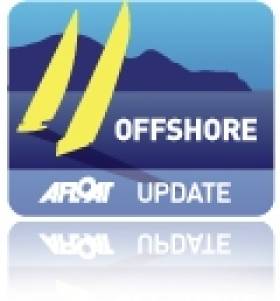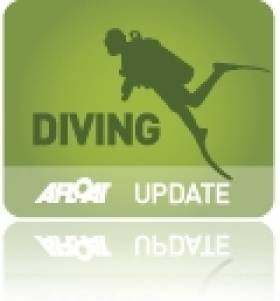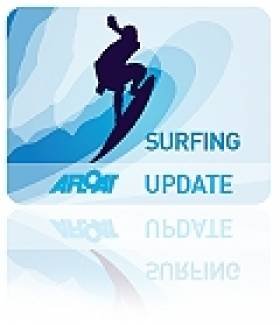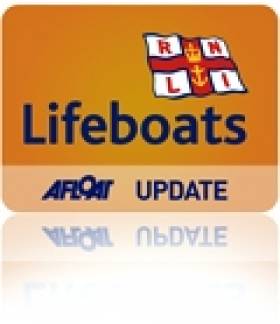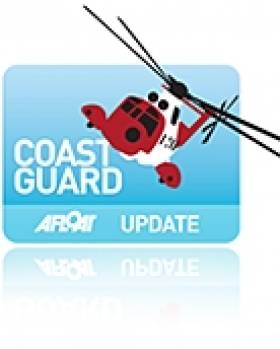Displaying items by tag: video
Kitesurfing Adventurer Plans Crossing From France to Ireland
#Kitesurfing - Bruno Sroka aims to complete an epic solo journey from France to Ireland on his kitesurfing board, powered only by the waves and the wind.
As Surfer Today reports, the French kitesurfer - who already has a crossing of the English channel to his credit - has set himself the challenge next month of surfing from L'Aber-Wrac'h in Brittany to the south coast of Ireland, a distance of some 240 nautical miles.
And it will be just the first of three adventures Sroka has lined up for himself, as he aims to follow this feat with a crossing of the Mediterranean in 2014, and finally the mighty Atlantic Ocean in 2015.
Indeed, his ambitious plans do little to dispel the impression that kitesurfing is a sport for the bravest alone - even too dangerous for the Olympics!
Surfer Today has more on the story HERE.
#RTIR - Winning tactical advice from some well-known names and faces associated with the Round the Island Race has been posted online ahead of the latest edition of the iconic annual event at the Isle of Wight.
Later today (31 May) will also see the official pre-race press conference on the eve of the 2013 JP Morgan Asset Management Round the Island Race, the 82nd anniversary of one of the most prestigious events on the world sailing calendar.
A terrific line-up of guests including Dame Ellen MacArthur and Alex Thomson will be on hand for the presser, which will be streamed live online and will also feature a tribute to the late Andrew 'Bart' Simpson, whose memorial service and private funeral is also being held today. The Island Sailing Club will fly the ensign at half-mast this afternoon.
Later this evening, the race competitors will meet for the all-important weather briefing. Racers will be given the latest weather and tidal information luve, coboned with tactical advice from Met Office-trained professional meteorologist Chris Tibbs.
In addition, competitors can evaulate the weather prior to the race by viewing the course overview and tidal strategy videos at the Raymarine website.
Among this year's competitors are Yvonne Margerison and her long-term partner Mike Flint, who are racing in their 20th Round the Island Race.
The couple entered their first back in 1993 in their boat Charis and have taken part almost every year since, apart from one when their mast was broken awaiting repair, and another when they sold Charis and were waiting to buy their new boat Gernee (S31) which is entered this year.
Margerison and Flint are passionate about sailing, have been very active members at Rutland Sailing Club - Flint is a past commodore - and both are former commodores at the Newparks Cruising Association Club.
While there's been talk of their retirement from racing - let's hope that won't be till after tomorrow's race, where race organisers hope they'll put in a strong showing.
How to follow the Round The Island Race action
The action begins tomorrow morning 1 June at 5am, and spectators can keep fully up to speed on the racing as it unfolds via the official Round the Island Race website, with features from the live blog to live race tracking, weather updates, and the latest news and results.
The race Facebook page and Twitter feed will also be maintained with the latest happenings. For those wishing to contribute to the Twitter news as the racers sail around the island, use the hashtags #RTIR and/or #RaceForAll to raise another £1 for the official charity, The Ellen MacArthur Cancer Trust.
New TV Series Unveils 'Secret Life of the Shannon'
#OnTV - Sunday 26 May sees the first of a two-part documentary series on The Secret Life of the Shannon on RTÉ One.
The series will take viewers on a journey along the River Shannon with wildlife cameraman and presenter Colin Stafford Johnson, who spent a year living on the river on a barge, camping on its banks and exploring its tributaries in a traditional canoe.
His quest was to film the natural history of the 340km of the Ireland's longest inland waterway as it has never been seen before - and if the above video is anything to go by, he's done an incredible job.
The Secret Life of the Shannon part of the RTÉ Goes Wild month-long celebration of Ireland's wildlife on television, radio and online.
Episode one will be broadcast on Sunday 26 May at 6.30pm on RTÉ One, with the second episode to follow at the same time on Sunday 2 June.
'Monster' Sighting In Lough Foyle Causes A Stir
#LoughFoyleMonster - Could Lough Foyle be hiding its very own version of the legendary Lough Ness Monster? As the video above attests, some witnesses to a mysterious sighting in the lake recently seem to think so.
According to The Canadian, a glimpse of what appears to be a large rock-like creature just breaching the surface of the water was captured by a group on the lough.
“It's really difficult to determine what species of creature it was," said one of the group. "I really don't think this can be a whale. I've seen whales, but I've never seen one swim like this before. Also, the pattern on it doesn't really look like it’s a whale.”
But before we all get too excited, consider that the group who made the video admitted that they were shooting for a student film called Fishing With David Lynch - a film and TV director well known for his other-worldly twists on reality.
Rondo Wreck Visit Reminder of Diving's Dangers
#Diving - With the Lusitania back in the news, Ireland's wealth of interesting diving sites are bound to draw attention this summer.
But it's worth remembering how dangerous an activity wreck diving can be - as Gizmodo reader Magicguppy relates in a special column for the tech news website.
He recalls his first ever shipwreck dive in September 2006, to the remains of the Rondo beneath the Sound of Mull in western Scotland.
"Used as a passage for shipping for centuries, it had a certain reputation for wrecking ships — even in 1935," writes Magicguppy, who goes on to depict in vivid detail how the ship went down, not to mention how the danger persists today for those who want to get close to the wreckage:
"The surface current swept my dive buddy and I towards the buoy. I turned and saw it gunning down on me. Grabbing the rope under the buoy, I signalled to my buddy.
"I knew that we had to get down below the current, and if we let go, even for a second, we wouldn’t be able to fight the current and get back onto the rope. My buddy agreed: Time to dive."
Gizmodo has much more HERE. But be warned - some of the gruesome descriptions in this story are not for the faint of heart!
#VOR - In the latest video updates from the Volvo Ocean Race, we follow the first completed hull and deck of the new design VOR 65 on an epic journey across Europe for assembly in the UK.
Following the March report, it was a race against time to transport these key components from Persico in Italy, via Multiplast in France, to Green Marine in Southampton.
The schedule was tight enough as it was without a sudden blast of wintry weather across the continent to contend with.
See more of the VOR video series Building The Future below:
Cornish Surf Pro Rides Ireland's Immense Winter Waves
#Surfing - Cornish surfing pro Tom Lowe took on Ireland's incredible winter waves, and has the video to prove it!
Shot by fellow Cornwall native Mickey Smith, the clip - via Surf Around Ireland - shows Lowe paddling into some of the biggest swells the west coast has to offer.
Get an Oar's Eye View of Coastal Rowing
#Rowing - St Michael's Rowing Club in Dun Laoghaire has posted the above video giving an oar's eye view of one of their regular evening coastal rowing training sessions.
As the description says, the three-and-a-half-minute clip was shot with a miniature GoPro camera attached to the end of an oar which "caught they action from warm-up to interval training to clubhouse".
It's certainly a unique perspective - though maybe not suitable for anyone prone to motion sickness!
First Outing for Skerries RNLI's New Lifeboat
#RNLI - Skerries RNLI recorded its first service by its new inshore lifeboat on Sunday afternoon (21 April). SEE VIDEO BELOW
The North Co Dublin lifeboat station's volunteer crew was requested to launch following a report that a vessel was adrift off Bettystown beach.
Crew members, alerted by their pagers, launched their new Atlantic 85 lifeboat Louis Simson within 10 minutes.
It was quickly established that the owner of the vessel was on shore. With the potential for the personal water craft (PWC) to pose a danger, the decision was made to locate it and return it to the beach.
Once on scene, a volunteer crew member was put on board the PWC and brought the vessel safely to shore.
Speaking following the callout, Skerries RNLI volunteer crew member Emma Wilson said: "The visibility was good today, but it was something quite small we were looking for, so being able to have an extra crew member on board our new lifeboat really made a difference during the search."
Howth Coast Guard Trains With Irish Red Cross
#Coastguard - Howth Coast Guard has blogged about its recent medical exercise with the Irish Red Cross.
The multi-casualty medical training exercise involved lowering a number of qualified and trainee emergency medical technicians (EMTs) into Whitewater Brook by the heights rescue team.
These EMTs served as serious trauma victims who were then retrieved through the joint effort of over 40 personnel between the two organisations who worked together to triage, treat and evacuate.
Another recent training exercise, as featured in the video above, involved the safe evacuation of a casualty with a lower limb fracture.
"One of the more common callouts we receive are for people enjoying walking or running in the area who slip and fracture a lower limb or ankle injury," said the North Dublin-based unit of the Irish Coast Guard.
"The team regularly train for this scenario, ensuring all members are able to stabilise, package, and evacuate by stretcher a casualty in this situation."



























